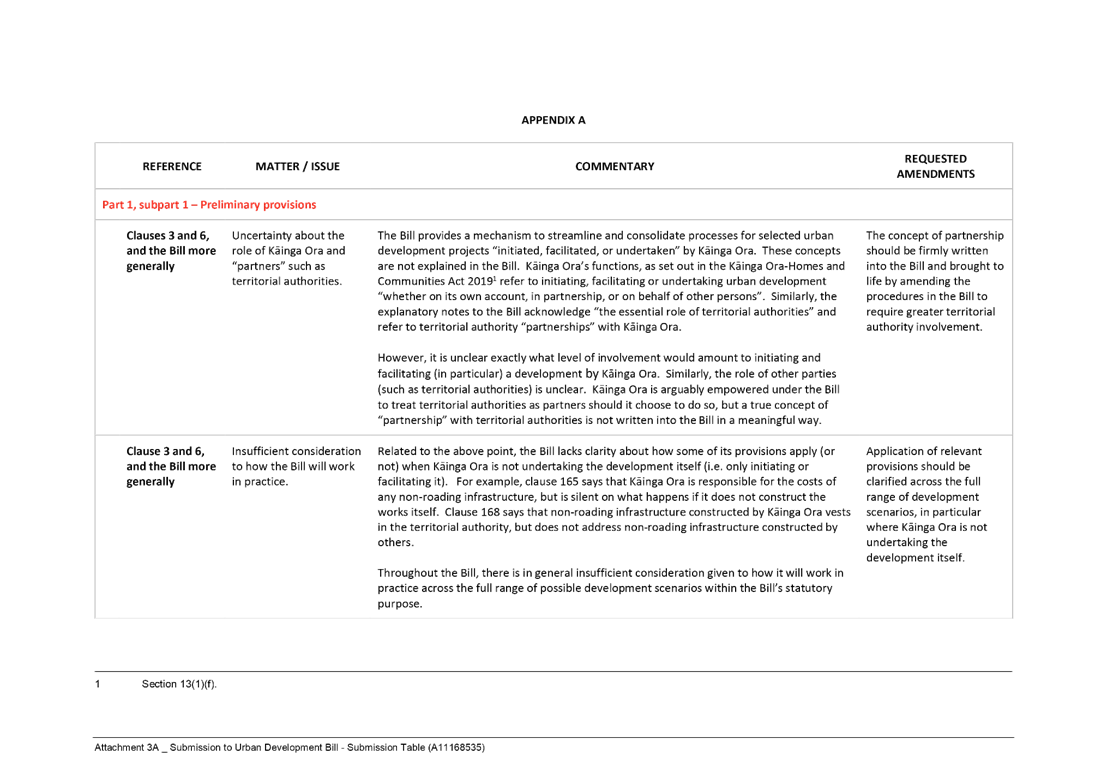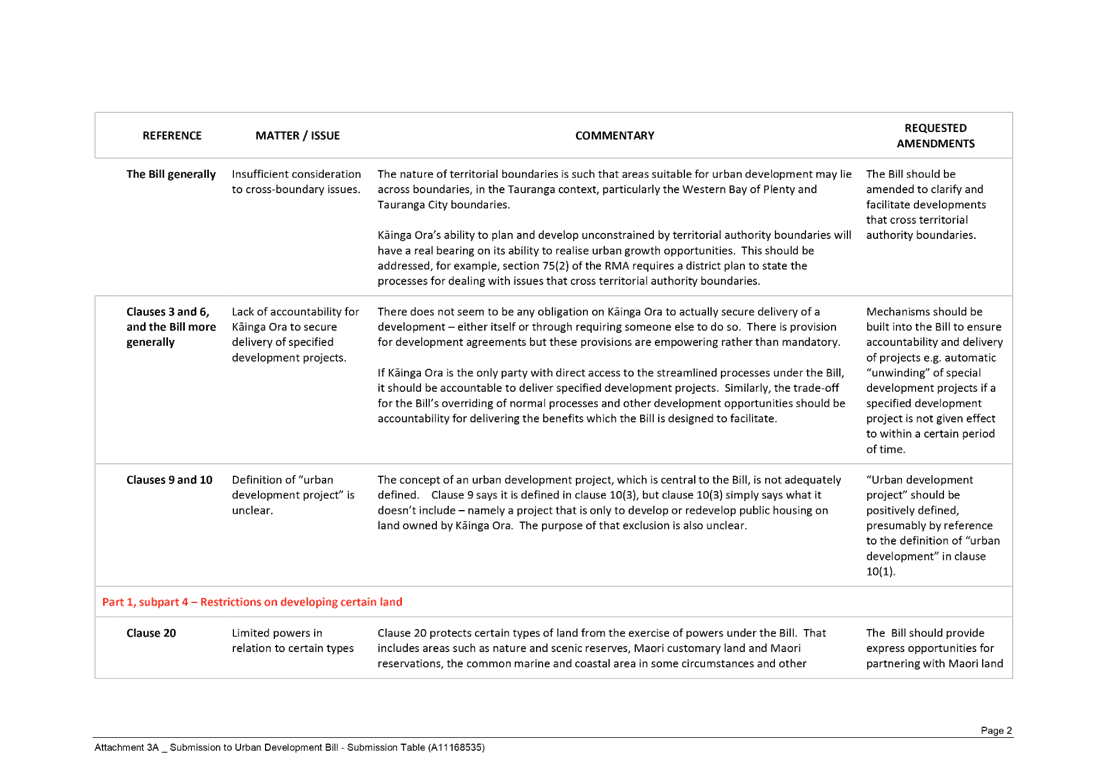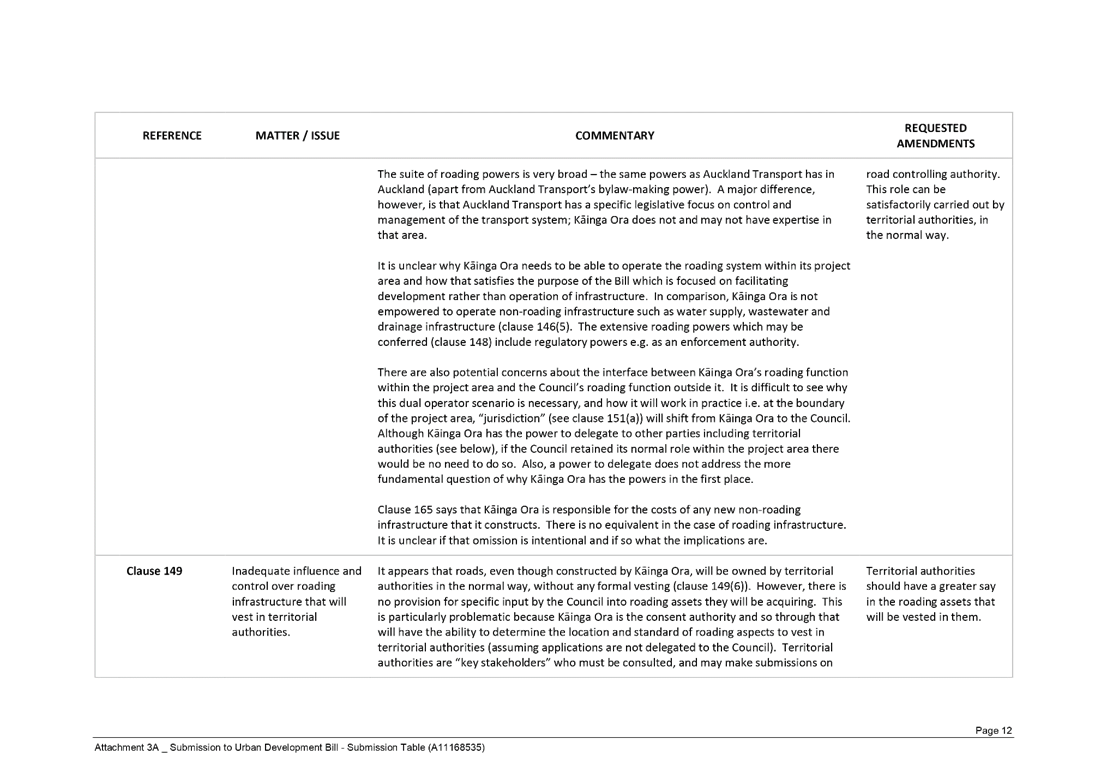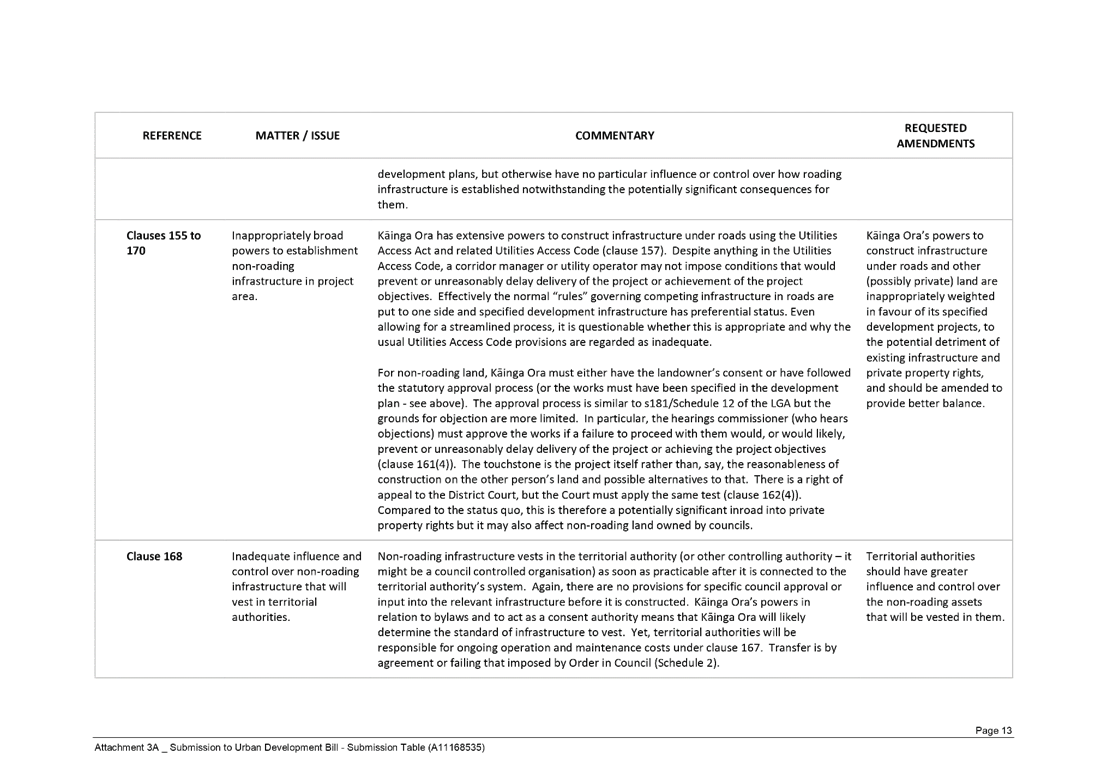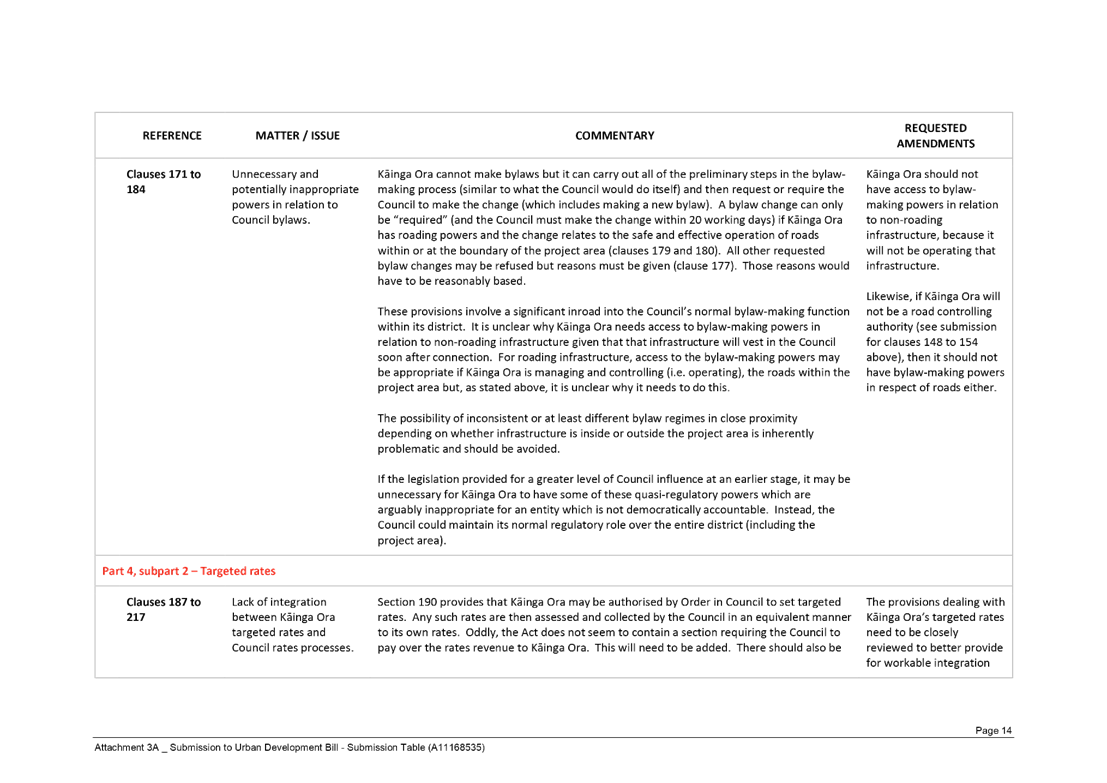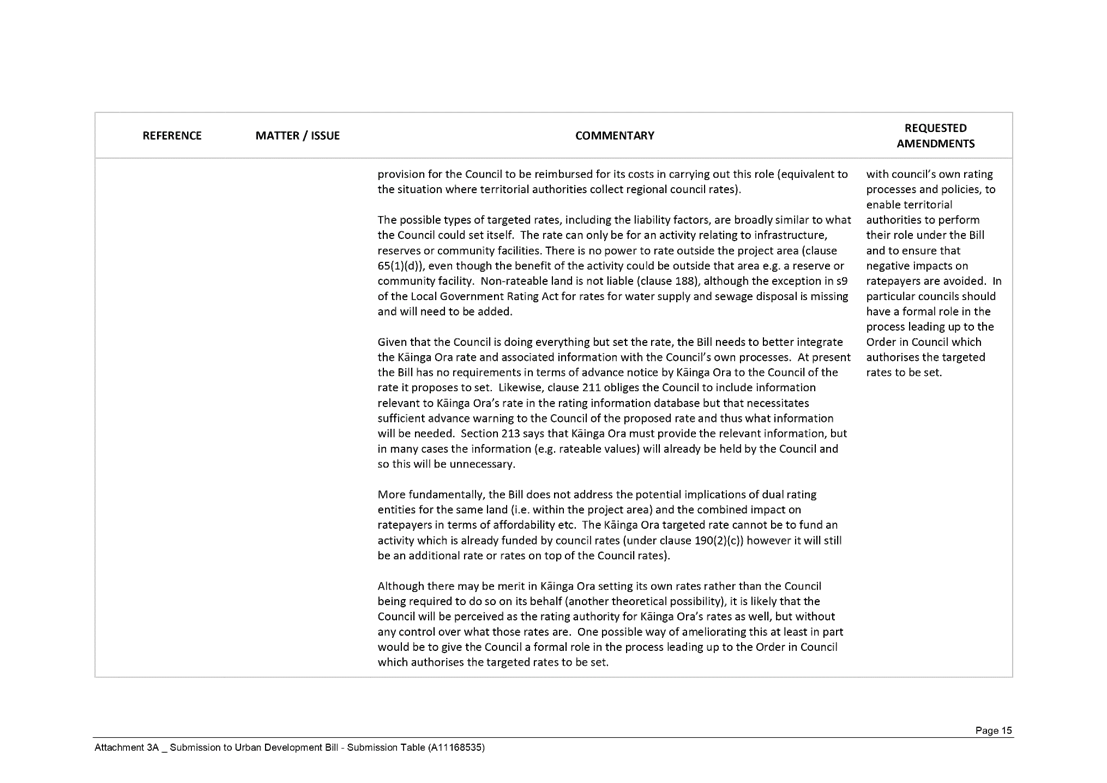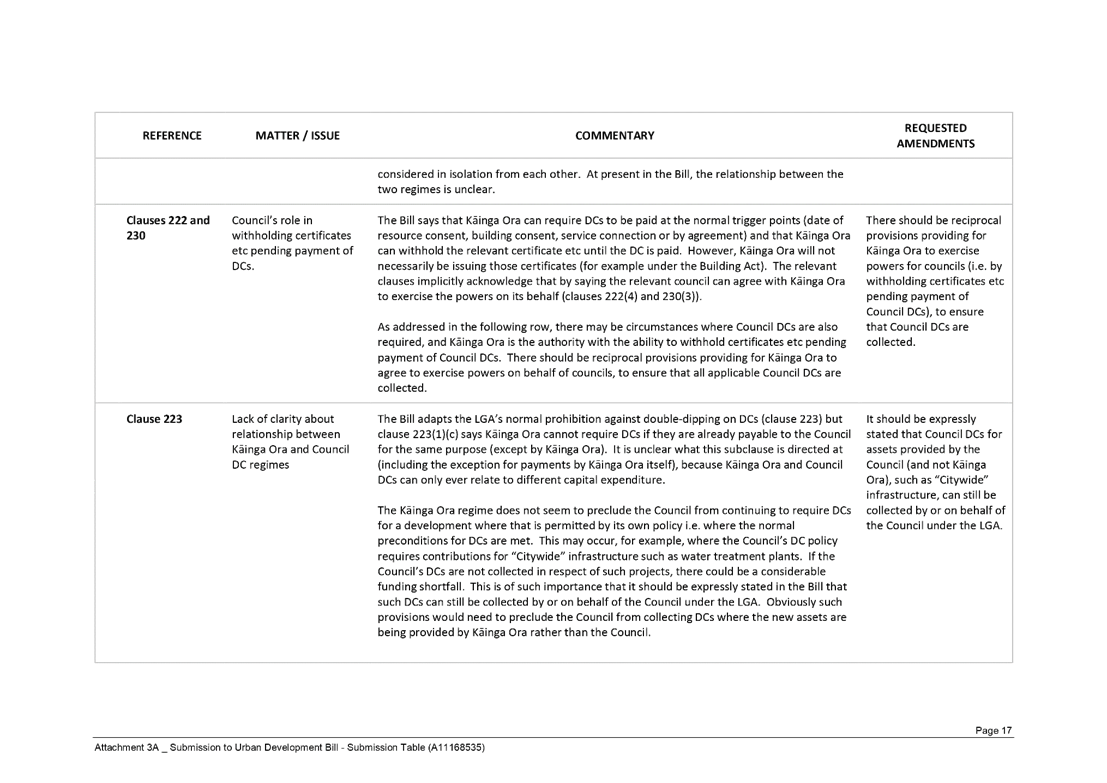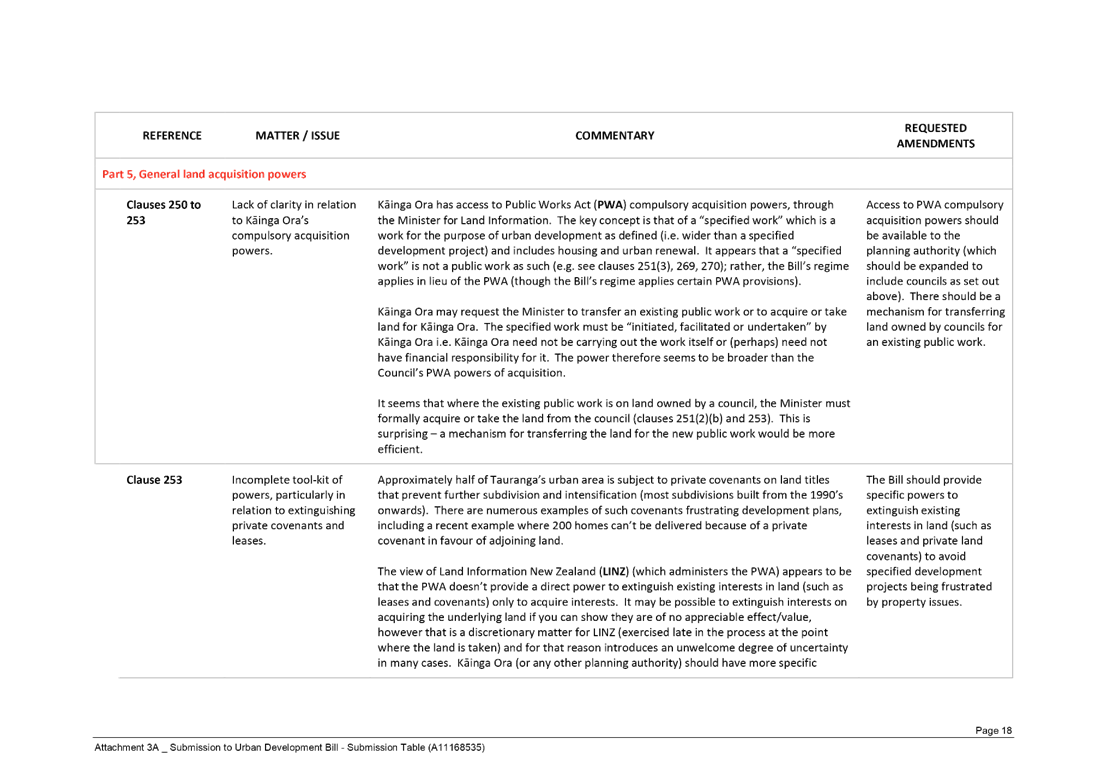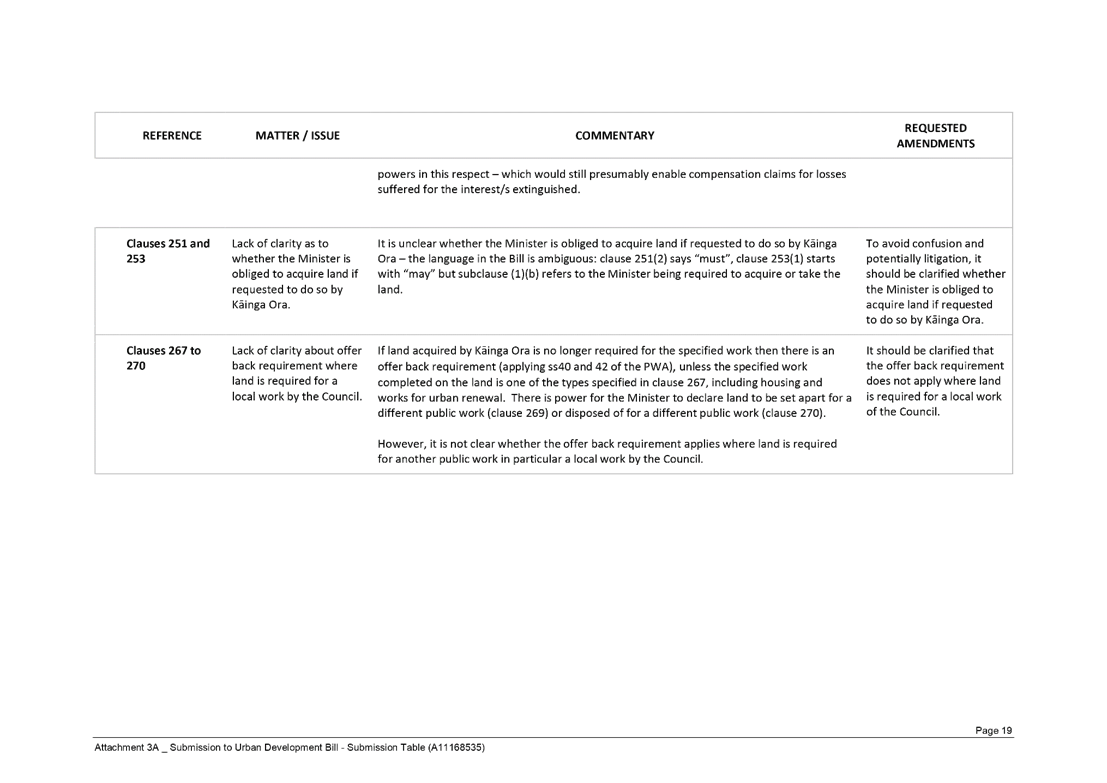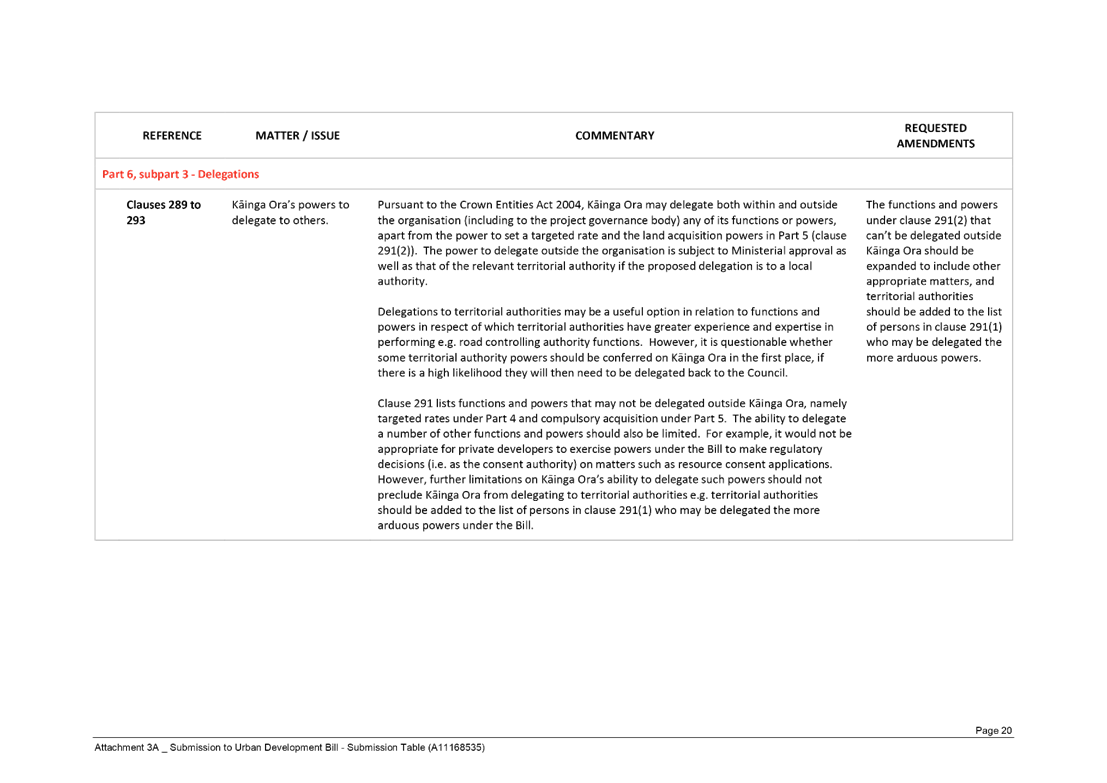|
Urban Form and
Transport Development Committee Meeting Minutes
|
27 November
2019
|
|

|
|
MINUTES
Urban Form and Transport Development Committee
Meeting
Wednesday, 27 November 2019
|
Order Of Business
1 Apologies. 3
2 Public Forum.. 3
3 Acceptance of
Late Items. 3
4 Confidential
Business to be Transferred into the Open. 3
5 Change to Order
of Business. 3
6 Declaration of
Conflicts of Interest 4
7 Business. 4
7.1 Growth
& Landuse Projects Progress Report - November 2019. 4
7.2 Transport
& Water Strategy and Planning Projects Progress Report 8
7.3 Urban
Form and Transport Initiative & Transport System Plan Projects Update. 12
7.4 Submissions
to Proposed RMA National Directions. 13
8 Discussion of
Late Items. 13
MINUTES OF Tauranga City Council
Urban Form and Transport Development
Committee Meeting
HELD AT THE Tauranga City Council,
Council Chambers, 91 Willow Street, Tauranga
ON Wednesday, 27 November 2019 AT
8am
PRESENT: Cr
Larry Baldock (Chairperson), Cr Heidi Hughes (Deputy Chairperson) Mayor Tenby
Powell, Cr Kelvin Clout, Cr Dawn Kiddie, Cr Jako Abrie, Cr Bill Grainger, Cr
Tina Salisbury, Cr Andrew Hollis, Cr Steve Morris, Cr John Robson
IN
ATTENDANCE: Marty Grenfell (Chief Executive), Paul Davidson (General
Manager: Corporate Services), Barbara Dempsey (General Manager: Regulatory
& Compliance), Susan Jamieson (General Manager: People & Engagement),
Christine Jones (General Manager: Strategy & Growth), Gareth Wallis
(General Manager: Community Services), Nic Johansson (General Manager: Infrastructure),
Andy Mead (Manager: City & Infrastructure Planning), Carl Lucca (Programme
Director: Urban Communities), Janine Speedy (Team Leader: City Planning),
Campbell Larking (Team Leader: Planning Projects), Alistair Talbot (Team
Leader: Transport Strategy & Planning), Claudia Helberg (Team Leader: Waste
Strategy and Planning), Clare Cassidy (Principal Transport Planner), Bruce
Robinson (Consultant), Jenny Teeuwen (Committee Advisor), Raj Naidu (Committee
Advisor), Robyn Garrett (Team Leader, Committee Support), Coral Hair (Manager:
Democracy Services)
1 Apologies
|
Apologies
|
|
Committee
Resolution UR1/19/1
Moved: Cr Kelvin Clout
Seconded: Mayor
Tenby Powell
That the apology for absence from Cr Bill Grainger and the
apology for lateness from Cr Steve Morris be accepted.
Carried
|
2 Public
Forum
Nil
3 Acceptance
of Late Items
Nil
4 Confidential
Business to be Transferred into the Open
Nil
5 Change
to Order of Business
Nil
6 Declaration
of Conflicts of Interest
Nil
7 Business
|
7.1 Growth &
Landuse Projects Progress Report - November 2019
|
|
Cr Steve Morris entered the meeting at 9.05am.
Staff: Andy
Mead, Manager: City & Infrastructure Planning
Carl Lucca, Programme
Director: Urban Communities
Janine Speedy, Team
Leader: City Planning
Campbell Larking, Team
Leader: Planning Projects
Te Papa Spatial Plan
Key Points:
·
Covered Te Papa peninsula - from Central Business
District (CBD) to Barkes Corner.
·
Similar process run in other areas across the
city.
·
Community and key stakeholders engagement was undertaken
in September/October. A summary of the engagement provided in the
attachment to the report.
·
Design workshops held last week looked at
series of options for moving forward.
·
Next steps – an options report would come
back to the Urban Form and Transport Development (UFTD) Committee early
next year, followed by further round of community engagement within the first
quarter of next year.
In response to questions:
·
Outcomes of the engagement were relatively
representative of Tauranga community as a whole.
·
Differences in numbers for responses showed
clarity between answers received from locals only, and responses received
from the broader community i.e. locals as well as those living outside the
area.
·
The next round of engagement would be more
explicit in terms of intensification, multi-modal transport options, and
green space (Green Necklace).
·
An integrated cross-over engagement approach
with businesses and land owners was being followed for the Te Papa project
and other TCC projects happening in the area.
·
Working closely with other councils to learn
from their intensification projects e.g. Hamilton City Council, Auckland
(Unitary Plan).
·
Analysis of community workshops feedback
identified some gaps, particularly in Gate Pa and Merivale. Tauranga City
Council (TCC) Community Development team had strong relationships with those
communities and were working closely with them to fill those gaps.
Intensification Plan Changes
Key Points:
·
Current direction from government required a
move to an up and out approach.
·
Change would take time, through multiple
property cycles.
·
A number of plan changes to City Plan were
being progressed prior to full City Plan review; the intensification
plan change was the largest.
·
Closely linked to the Te Papa Spatial Plan
project.
·
Main objective of the intensification plan
changes was to provide a range of housing typology across all the residential
zones of the city.
·
Working through a similar streamlined plan
change process as the Auckland Unitary Plan and the Christchurch Replacement
Plan.
·
Formal submission process with the public would
be around August 2020.
In response to questions:
·
Future car parking requirements - awaiting
outcomes from National Policy Statement (NPS)–Urban Development
submissions as these could influence plan changes.
·
Design elements that could be incorporated
into a development to improve the quality of the look and feel were being
considered.
·
The establishment of a Design Panel was being
considered as part of the city plan review.
·
Intensification plan changes were limited in
scope to residential development within the suburban residential zones and
commercial zones. Minimum carparking requirements were citywide except
within the CBD.
·
Not looking to entirely remove parking
minimums but better target them while allowing provision for special
circumstances.
·
The ability for an existing dwelling to be
changed into a duplex was currently dependent on lot size. A report would
come to UFTD Committee in early 2020 to confirm the City Plan Hearings Panel
make up and also to confirm ability to continue with the streamlined planning
process. Hearings not until early 2021.
Storm Water Plan Changes
Key Points:
·
Plan change was in relation to addressing the
modelled flood risks caused by intense rainfall.
Earthworks Plan Changes
Key Points:
·
Plan changes were to make minor technical
changes to enable better enforcement of sediment control; as well as to tidy
up subdivision earthworks requirements.
In response to questions:
·
The plan change was not offering more or less
protection, but was providing council with more options to enforce rules.
Tauriko West Urban Growth Area
Key Points:
·
Process to bring the area into the Tauranga
City district was going well.
·
The transport plan was currently on hold due
to a change of direction to transport priorities by the new government. Consequently,
TCC had been funding an early works package to enable housing in the area.
This included improvements to Cambridge Rd, some limited widening of the
state highway network, an access point to Tauriko West on the upper plateau,
and a new roundabout and southern connection to the Tauriko business estate.
·
Originally only enough infrastructure capacity
created for the Tauriko business estate area and the Lakes; Tauriko West was
not taken into account.
·
Housing numbers and densities – only
about half of the area was developable for houses; approximately 3000
houses with densities of around 18-20 houses per hectare.
In response to questions:
·
Road currently not up to standard .
TCC’s early works package only bought a little additional time. Significant
investment was needed – upwards of ½ billion dollars.
TCC’s focus was on long-term planning for when NZTA restarted the
business case for SH29.
·
Tauriko was a minimum 10-year development, two
housing cycles. There would be opportunities for higher densities and more
housing typologies over time.
·
TCC would like Tauriko West residents to be
able to access shops and the Tauriko business estate without going onto the
highway network. When the NZTA business case process re-opened. TCC would be
pushing for a better connection above or below the main highway.
Te Tumu Urban Growth Area
Key points:
·
Covered area twice the size of Tauriko West
and had the same planning issues but was an easier landform to work with.
·
Te Tumu was a 30-year development project.
Growth would open up as infrastructure became available; would be two to four
housing cycles before finished.
In response to questions:
·
In terms of operational costs, TCC had a
partnership approach with developers for funding contributions to planning.
Future Urban Growth Areas –
Keenan Rd and Tauriko Business Estate
Key Points:
·
Keenan Rd - expansion of the Lakes
development further southward.
·
Tauriko Business Estate – expansion in
the lower lying areas south of Belk Rd.
·
Both projects were located in Western Bay District.
Local Government Commission currently considering submissions to bring these areas
into Tauranga City.
|
|
Committee
Resolution UR1/19/2
Moved: Cr
Larry Baldock
Seconded: Cr
Steve Morris
That the Urban Form and Transport
Development Committee meeting be extended past the 2 hour time period.
Carried
|
|
Welcome Bay Planning and Ohauiti
Study
Key Points:
·
Investigations into social
infrastructure as well as 3 Waters and transport infrastructure in Welcome
Bay completed.
·
There was significant opportunity for further
development in both Welcome Bay and Ohauiti; with the main constraint being
transport.
·
A report to consider next steps would come
back to Council in March /April 2020.
In response to questions:
·
Free school bus trial currently happening in
Welcome Bay.
Rural Land Study
Key Points:
·
The Rural Land Study was being finalised.
·
The findings of the study would be reported to
Council in 2020.
Smith’s Farm
Key Points:
·
Council owned special housing area
·
The biggest challenge was transport access. Substantial
cost . Continued work on access options and how front end costs could be
mitigated.
Government Policy & Initiatives
Key Points:
·
A substantial review of the Resource Management
Act (RMA) was planned. An initial consultation document was out with
submissions due by 3 February 2020.
·
Another key initiative of the Government was
the establishment of Kainga Ora.
Natural Hazards and Resilience
Key Points:
·
Current work programme covered the development
of an earthquake natural hazard model.
|
|
Committee
Resolution UR1/19/3
Moved: Cr
Larry Baldock
Seconded: Cr
Andrew Hollis
That the Urban, Form & Transport
Development Committee
(a) Receives
the Growth & Land Use Projects Progress Report – November 2019
Carried
|
|
Committee
Resolution UR1/19/4
Moved: Cr
Larry Baldock
Seconded: Cr
Steve Morris
That the Urban Form & Transport Development
Committee meeting be adjourned at 10.15am until 1pm.
Carried
|
|
Meeting resumed at 1.30pm.
Mayor Tenby Powell and Cr Dawn Kiddie
left the meeting at 1.30pm.
|
|
7.2 Transport
& Water Strategy and Planning Projects Progress Report
|
|
Staff: Andy
Mead, Manager: City & Infrastructure Planning
Alistair
Talbot, Team Leader: Transport Strategy &
Planning
Claudia
Helberg, Team Leader: Waste Strategy and Planning
Key Points:
Transport Planning Projects
·
Urban Form and Transport Initiative (UFTI) and
Transport System Plan (TSP) projects were covered in a separate report, item 7.3
of this agenda.
·
Infrastructure Development Code (IDC):
-
Work was progressing on the technical toolbox
to support the IDC and feedback on testing/peer review continued to be sought
and received.
In response to questions:
-
With intensification and small lot sizes, the
issue of one tree per lot had been addressed i.e. where one tree per lot was
not practical, these would be replaced with a cluster of trees within the
street.
·
Parking Strategy:
-
Following a workshop with Mayor and
Councillors in September 2019, work undertaken to date had been referred to
UFTI to ensure alignment.
-
Ministry for Environment (MfE) response to
submissions on the National Policy Statement-Urban Development, which
included potential direction on parking management, was expected in 2020.
In response to questions:
-
Parking was a self-funding activity - income
from parking went back into parking. Parking revenue was also
ringfenced for investment in public transport infrastructure.
·
Park n Ride:
-
A Park n Ride study had been undertaken to
understand where and under what conditions Park n Ride could be successful in
the city.
-
Opportunities were being investigated with a
focus on identifying any site or sites that could be established in the short
term.
In response to questions:
-
TCC was currently working with Regional
Council and the Transport Agency to better understand opportunities for the
Bayfair/Baypark corridor and how these might fit together.
·
Tauranga Transport Model:
-
The model had undergone a significant rebuild
exercise over the last 12-18 months. The model was a partnership
exercise between the Transport Agency, Regional Council, Western Bay of
Plenty District Council and TCC, administered by TCC.
-
Next steps focused on the integration of cycle
and census information into the model. Some of the census work had been
delayed.
In response to questions:
-
Census information had been published at a
city-wide level. TCC was awaiting specific spatial allocation
information expected to be available by March 2020.
·
Eastern Corridor Transport Planning:
-
The Papamoa Eastern Interchange (PEI) was key for
transport planning; for access to the Wairakei town centre, industrial areas
in the area and the future Te Tumu urban growth area.
-
The Interchange project was led by TCC and was
well into the design phases.
-
Estimated cost was upwards of $50m for the PEI
and $100m for the full programme – mostly funded by development
contributions.
-
Five years away from being operational.
-
TCC successful in receiving NZTA contribution
towards transport projects including the PEI via the Housing Infrastructure
Fund.
In response to questions:
-
TCC’s contribution to the PEI would be
50% of the estimated $50m cost.
·
Hairini Causeway / Turret Road:
-
Investigations into tidal flow options were
continuing.
-
Need to align with UFTI to understand the
future role of the corridor and its function.
-
Clarity from UFTI would help form and design
solutions to deliver that function.
In response to questions:
-
If the existing bridge was three-laned, a
separate bridge for pedestrians/cyclists would be required.
-
UFTI work would give more certainty to cycle
plan routes for this area.
-
Some structural integrity work had been completed
on existing bridge to understand load capacity. Tidal flow option was
explored as an interim measure. Once UFTI work was completed, a
robust options assessment process could take place, which would come to
Council to consider and prioritise.
-
Previous council had requested other corridor
options be explored around the Turret Rd bridge. Some work had been
done on going off line (back of bay) from the current route of 15th
and Turret, followed by a design/modelling exercise for the tidal lane
idea. Going around the pohutukawa trees had been discounted.
-
People travelling from Welcome Bay were
predominately travelling to the main industrial area and CBD for employment ,
and to schools.
State Highway Projects
·
Baylink update
-
Public transport priority and pedestrian /
cycling crossing facilities testing and modelling to be completed in November.
·
State Highway 2 (including Tauranga Northern
Link)
-
Project remained on hold.
·
Western Corridor
-
Working with Regional Council and Western Bay
District Council to investigate infrastructure improvement as part of the early
works package.
·
17th Ave connection to Takitimu
Drive
-
Project still at the feasibility /
investigation stage.
·
Hewletts Rd – Short term investigation
-
Limited options for short term improvements had
been identified and included traffic signal phasing, improved lane marking,
improved parallel street connections and improved pedestrian connections.
In response to questions:
-
The airport trail cycleway was part of the
next stage of the investigation for cycle routes.
Multi Modal Projects
·
Arataki Corridor improvements
In response to questions:
-
Longer term cycleway improvements part of next
stage of the investigation for cycle routes.
·
Arataki bus facility
-
Two potential sites shortlisted –
Bayfair (accessed from Farm St) and Arataki Park (St John Ambulance site).
-
Staff currently working with Bayfair to
understand the feasibility of the Bayfair site.
-
Options for both sites to come back to council
for consideration.
In response to questions:
-
Underpass – there were a range of issues
for the site including stormwater, space, and bus links.
-
It was requested that information on the
Arataki bus facility be made available to councillors.
·
City Centre bus facility
In response to questions:
-
It was requested that information on the city
centre bus facility be made available to councillors.
·
Cameron Rd corridor improvements
-
The current stage of the project focused on the
short term, up to 10 years. Work contributed towards achieving
multi-modal and quality intersection outcomes.
-
The preliminary design exercise included
community engagement and workshops.
·
Cycle Plan Implementation
-
The tender process for route option selection
assessments was underway.
In response to questions:
-
Funding had been approved for the Ngatai Road
cycle way.
·
Public Transport Implementation Plan
-
TCC staff continued to work with BoPRC on
this.
Projects General
·
NZTA Funding
In response to questions:
-
Domain Rd – notification had been
received from NZTA that funding was approved.
-
Maungatapu bridge was state highway and was
part of the UFTI work.
Cr Andrew Hollis left the meeting at
2.30pm.
Waters Planning Projects
·
Eastern Corridor wastewater study
-
Estimated concept costs had been reviewed and
a significant increase from $60m to an estimated base cost of $100m
identified, with a 95th percentile budget estimate of $150m.
In response to questions:
-
50 percentile estimate was (roughly) the
expected project cost. 95 percentile estimate built more risk into the
cost estimate.
-
Most of these projects were planned for 2021
and beyond; were signalling what may come in the Long Term Plan (LTP).
-
In the short term, further discipline around risk-based
programming, scheduling and costings was being introduced.
-
Allocation of confidence levels to financial
budgets would be considered for the LTP to provide better clarity.
-
Was opportunity for multi benefits with other
pieces of work undertaken at the same time (undergrounding of power, roading
etc).
·
Western corridor wastewater study
-
Looking at new growth areas – Tauriko
West, lower and upper Belk, Keenan, Joyce and Merrick Road areas.
-
Indicative cost for the western extension was
$100m.
-
Growth in the western corridor was occurring
faster than anticipated.
In response to questions:
-
The project would be growth funded, including
development contributions and possibly through IFF (Infrastructure Funding
and Finance - legislation was being introduced in Parliament shortly).
·
Te Maunga Ocean Outfall project
In response to questions:
-
Relining of the existing outfall pipe was
currently being assessed, which might allow the deferral of a new outfall.
|
|
Staff
Action
|
|
Provide information on the following to
Councillors:
·
Arataki bus facility.
·
City centre bus facility
|
|
Committee
Resolution UR1/19/5
Moved: Cr
Kelvin Clout
Seconded: Cr
Jako Abrie
That the Urban Form and Transport
Development Committee
(a) Receives
the Transport & Water Strategy and Planning Progress Report –
November 2019.
Carried
|
|
7.3 Urban
Form and Transport Initiative & Transport System Plan Projects Update
|
|
Staff: Alistair
Talbot, Team Leader: Transport Strategy & Planning
Key Points:
·
Background was provided on the Urban Form
& Transport Initiative (UFTI) and the Transport System Plan (TSP).
·
Next step for UFTI was the development and
delivery of the Interim Report, due by the end of 2019.
·
Next steps for TSP were to commence the tender
process for the delivery of the TSP and to continue to work with key partners
to confirm roles and involvement in the project’s development and
delivery.
|
|
Committee
Resolution UR1/19/6
Moved: Cr
Tina Salisbury
Seconded: Cr
Steve Morris
That the Urban Form and Transport
Development Committee
1. Receives
the report Urban Form and Transport Initiative & Transport System Plan
projects update.
Carried
|
|
7.4 Submissions
to Proposed RMA National Directions
|
|
Staff: Andy
Mead, Manager: City & Infrastructure Planning
Key Points:
·
National Policy Statements had been proposed
for urban development (NPS-UD), highly productive land (NPS-HPL), and
freshwater management, as well as a National Environment Standard for
freshwater management (NPS & NES-FM).
·
TCC had made submissions to these proposals,
lodged by the Chief Executive.
·
Potential impact of these proposals on
Tauranga and key submission points were set out in the report.
·
A joint submission was provided by Bay of
Plenty Regional Council, Tauranga City Council, Kawerau District Council.
Western Bay of Plenty District Council, Whakatane District Council and
Opotiki District Council to Government’s Action for Healthy Waterways
proposal.
In response to questions:
·
The joint Bay of Plenty submission was raised
by regional council with a view to provide a one voice submission to
highlight the high level issues across the whole of the Bay of Plenty.
·
Submissions were an effective mechanism to
provide feedback to Government in terms of urban development and meeting
Government’s urban growth agenda.
·
TCC was looking strategically at the whole of
the water network, what volumes could be put through each plant and what
volumes were needed for the city. Currently working on Policy at the
front end. Once the policy level moved into the implementation framework stage,
scenario and costing analysis would be undertaken.
|
|
Committee
Resolution UR1/19/7
Moved: Cr
Heidi Hughes
Seconded: Cr
Tina Salisbury
That the Urban
Form & Transport Development Committee:
(a) Receives
the submissions attached to this Report on the proposed urban development,
highly productive land and freshwater National Policy Statements and National
Environmental Standards subject to the Resource Management Act.
Carried
|
8 Discussion of
Late Items
Nil
The Meeting closed at 3.13pm.
The minutes of this meeting were
confirmed at the Urban Form and Transport Development Committee Meeting held on
_________________________.
...................................................
CHAIRPERSON
8 Business
8.1 Submissions
to draft National Policy Statement on Indigenous Biodiversity, Resource
Management Systems Reform & Urban Development Bill
File
Number: A11141191
Author: Andy
Mead, Manager: City & Infrastructure Planning
Authoriser: Christine
Jones, General Manager: Strategy & Growth
Purpose of the Report
1. To provide the Committee
with a copy of the submission lodged by the Chief Executive on the Issues and
Options Paper released by the Resource Management Review Panel, and drafted
submissions to the draft National Policy Statement for indigenous biodiversity,
and the Urban Development Bill.
|
Recommendations
That the Urban Form and Transport Development Committee:
(a) Receives the submission
(Attachment 1) on the Issues and Options paper for the Resource Management
Systems Reform lodged with the Resource Management Review Panel on 3 February
2020;
(b) Endorses the draft
submission (Attachment 2) on the draft National Policy Statement for
Indigenous Biodiversity for submission to the Minister for the Environment;
(c) Endorse the draft submission
(Attachment 3) on the Urban Development Bill for submission to the NZ
Government’s Environment Committee.
|
Background
2. At the end of 2019,
central Government released a series of documents requesting public input
including the:
(a) Issues and options paper
prepared by the Resource Management Review Panel associated with the
comprehensive review of the resource management system;
(b) Draft National Policy
Statement for indigenous biodiversity (NPS-IB); and
(c) Urban Development Bill (UD-B);
3. Each of these proposals
have differing submission periods. It is noted that comments on the
issues and option paper to the review of the resource management system were
due prior to the UFTD meeting on 13 February. As a result, TCC has
provided staff comments to the expert panel on this paper, which were lodged by
the Chief Executive on 3rd February 2020. These comments are
included as Attachment 1.
4. Submissions to the other
two consultation processes are as follows:
(a) UD-B: due on 14 February 2020
to the NZ Government’s Environment Committee; and
(b) Draft NPD-IB due on 14 March
2020 to the Minister for the Environment.
5. All three proposals
subject to this report deal with a range of resource management matters that
could impact on planning and urban development across the City.
6. The purpose of these
documents is summarised below:
(a) Urban Development Bill
(i) This UD-B follows on
from Kāinga Ora-Homes and Communities Bill, which disestablished Housing
New Zealand and set up a Crown urban development agency, which includes the
former Housing New Zealand but has a broader urban development and housing
development enablement and delivery focus.
(ii) The overarching aim of the
bill is to provide Kāinga Ora with powers to facilitate complex
development projects (to be referred to as specified development projects
– SPDs) within urban areas across the country. The bill would give
Kāinga Ora with access to a tool-kit of development powers when
undertaking SDPs; including access to compulsory land acquisition powers.
These powers are in lieu of the Council, who would
normally carry out the role.
(iii) Kāinga Ora would have
the ability to undertake development projects by itself, or partner with iwi,
local Government or the private sector.
(b) Issues
and options Paper – RM Review (Stage 2)
(i) In November 2018, the
Government announced a two-stage process to improve the resource management
system. Stage one included the introduction of a Bill to reverse some of
the changes introduced through the Resource Legislation Amendment Act 2017,
such as the prevention of public notification and appeals by applicant and submitters
in residential and subdivision consent applications. This Bill is
currently with the Environment Select Committee for consideration.
(ii) Stage two of the RMA review
commenced with the appointment of an expert review panel in July 2019, chaired
by retired Appeal Court Judge Tony Randerson. The panel is expected to
produce a final proposal (due end of May 2020) for reform that addresses the
Government’s intention to cut complexity and costs and better enable
urban development, while also improving protection of the environment. In
the lead up to the final proposal, the expert panel released an Issues and
Options paper in November 2019, identifying the main issues to be addressed and
options for reform. This paper invites comment on the issues and options
identified to help inform the panels final proposal. TCC previously
provided comments to the Minister as part of the establishment of the Terms of
Reference for the expert review panel. In those comments a number of
matters were raised which have been identified as part of the Issues and
Options Paper.
(c) Draft National Policy
Statement-Indigenous Biodiversity
(i) In November 2019, the Minister for the Environment
released the draft National Policy Statement on Indigenous Biodiversity
(NPS-IB) for submission. The purpose of this NPS-IB is to set out
objectives and policies in relation to maintaining biodiversity that is
naturally occurring anywhere in New Zealand. This includes all New
Zealand’s ecosystems, native vegetation and fauna and the habitats of
native vegetation and fauna.
(ii) The draft NPS-IB specifies what local authorities must
do to achieve these objectives, which will include the requirement for
Council’s to identify and map significant natural areas (SNAs).
(iii) The
draft NPS-IB seeks a step change in the management and protection of indigenous
biodiversity. The fundamental framework adopted in this NPS-IB to achieve
an integrated and holistic approach to maintaining indigenous biodiversity is
Hutia Te Rito. This framework recognises that the health and wellbeing of
the terrestrial environment, its ecosystem and unique indigenous vegetation and
fauna, is vital for the health and wellbeing of the wider environment and
communities. The NPS-IB requires this framework to be “recognised
and provided for”. Council will also need to provide opportunities
for tangata whenua to be involved in the development of plans, policies and
strategies that give effect to the NPS-IB, and the NPS-IB sets out measures for
identifying and managing taonga species or ecosystems.
7. A
summary of the relevant matters and potential impacts of these proposals on
Tauranga and the key submissions points on these proposals is set out below:
(a) Urban Development Bill
(i) The
UD-B provides extensive powers to Kāinga Ora, which may potentially affect
Council in a number of different capacities (rates, infrastructure planning and
servicing, development contributions, open space etc). It is however
noted that opportunity is provided for within the UD-B to delegate many of the
functions of Kāinga Ora to a local authority.
(ii) The
range of powers afforded to Kāinga Ora may not be complete in regard to
enabling the delivery of urban development. This includes for example the
ability to address private land covenants which can often be restrictive to
redevelopment proposals or extinguish leasehold interests in land.
(iii) The
UD-B makes streamlined processes available to Kāinga Ora in relation to
developments which Kāinga Ora initiates, facilitates or undertakes. However,
there is no provision for local authorities to have direct access to these
processes or lead the project assessment process or prepare a development plan
(which is the key document for the exercise of powers under the UD-B –
encompassing both RMA and non-RMA tools for planning, funding and delivering
specified development projects). In regard to process, Council’s
role appears to be more as a stakeholder, rather than a true partner.
(iv) The
UD-B has an overall stance of “development at any cost” which is at
odds with the need to ensure that development under the UD-B occurs in a manner
which is appropriate and integrates with the exercise of its wider functions,
duties and powers (and Council’s overall strategic and implementation
functions).
(v) The
impact of an SDP on the exercise of the Council’s wider functions and
duties and powers. In this regard Councils are insufficiently protected
or provided for in relation to many aspects of the specified development
project process which will directly impact on them. In particular:
the
automatic vesting of Kāinga Ora-built infrastructure (which may not be
designed in accordance with TCC’s infrastructure development code);
obligations
relating to targeted rates (which TCC may need to collect on behalf of
Kāinga Ora);
development
contributions levied by Kāinga Ora and what Kāinga Ora’s DC
policy should include (i.e. it is not clear whether Kainga Ora must adhere to the Tauranga Development Contribution
Policy in setting up a development project including ensuring payment is made
for network infrastructure provided by the city such as water and wastewater
treatment plants);
the
ability to influence or direct council bylaws.
(vi) From a regulatory perspective, the
emphasis on urban growth could lead to a concern that environmental protection
is given lesser weight in decision-making.
(ii) From
an urban growth perspective, the development emphasis substantially improves
the likelihood of achieving more intensive urban growth outcomes.
(b) Issues
and Options Paper – RM Review (Stage 2)
(i) Improving the alignment
between key legislation and the priority and function that these have in the
overall Resource Management (RM) process is considered critical.
An example of this is the relationship between the RMA and the Building Act
2004 particularly in terms of natural hazard management. Review of this
relationship between legislation is supported with better alignment between the
RMA and Building Act (including relevant determinations).
(ii) There is a need to have
national direction on natural hazards and that this sits within a single piece
of legislation and is led by central government. Councils need greater
direction from central government on natural hazard management and risk and the
expected outcomes to better enable a standardised approach across New
Zealand. The benefit of this consideration is that it will result in a
holistic response to natural hazards, rather than requiring each regional or
local authority to address natural hazards. It is suggested that the LGA, LTMA
and Building Act have clear functions in their roles and responsibilities.
(iii) Support for the proposal to
legislatively mandate spatial planning (including strategies, such as the
SmartGrowth Strategy and draft Tauranga Urban Strategy), and guidance on how
these are implemented through resource management plans, and also consenting
processes This provides an opportunity to also revisit the need for
continual community input throughout the current RM process where critical
matters can instead be addressed at a spatial planning stage (and then supported
through a simplified consenting process);
(iv) Need for improvement in clarity and
of priority for infrastructure delivery and housing within Part 2 (Purpose and
Principles) of Resource Management Act 1991;
(v) There remains a need to
develop a clear planning hierarchy, particularly given the recent drafting of
multiple national directions. These directions have competing interests
and the way in which they are drafted and interpreted by the court creates
issues when attempting to balance these interests at a local level. As
such, this review now has the opportunity to also consider the hierarchy of
National Policy Statements and identifying what other National Policy Statements
may be required (e.g. natural hazards) and also the program of development of
National Environment Standards to aid in developing consistency of approaches
in the implementation to nationally important issues.
(vi) Resourcing and capacity building is
required to address the nationwide lack of technical expertise (across all
levels) to deliver on the range of resource management frameworks (current and
proposal national policy statements etc); this includes capacity building for Māori
and their input into plan making and consenting processes.
(c) Draft National Policy
Statement-Indigenous Biodiversity
(i) That territorial
authorities need to identify and classify areas with significant vegetation and
habitats of indigenous fauna as significant natural areas (SNAs), however there
is unnecessary complexity in the methodology.
(ii) The
identification of SNAs must be carried out using an extensive list of criteria
set out within the NPS-IB. SNA’s must then be assigned with a high
or medium rating. The proposed methodology for identifying and
classifying SNA’s is complex, and whilst the criteria and attributes are
set out in the NPS-IB there is no implementation guidance provided other than
the assessment must be conducted by a suitably qualified ecologist. This
has the potential to still lead to inconsistency of application not in line
with the policy statement intent.
(iii) In
addition to requiring significant restrictions on activities within or
affecting these SNAs, the draft NPS-IB also requires councils to develop district
plan provisions (rules) to maintain indigenous biodiversity outside SNAs.
There will be difficulty in adhering to this requirement when creating controls
on subdivision, use and development in areas outside SNAs.
(iv) The
proposal to achieve a target for indigenous vegetation cover within urban areas
of 10% is potentially problematic. The Council currently contributes to
indigenous vegetation cover through revegetation and maintenance programmes to
the maintenance and enhancement of biodiversity. The Tauranga City Plan
currently has approximately 520 hectares of conservation zoned land across the
City. There are 43 recorded significant ecological areas with an
approximate area of 500 hectares (noting that some of these are located within
the conservation zone). The area of all significant ecological areas in
the City Plan represents approximately 4 percent of the city’s total land
area. This excludes the areas located within the harbour and surrounding
estuaries which are not covered by the proposed NPS-IB. The draft NPS-IB
expects all these existing areas to be reassessed using the updated
methodology.
(v) The
methodology proposed under the NPS-IB to identify and then map new SNAs will
take a considerable amount of time and be costly and likely lead to a
significant increase in areas given the attributes and criteria now listed
within this methodology. The NPS-IB will therefore likely result in
significant additional areas being set aside to achieve the purpose of the
NPS-IB. This could include, subject to further assessment in accordance
with the proposed methodology, additional land within growth areas such as Te
Tumu and Tauriko West which presently is not identified as being an area of
biodiversity or other feature (i.e. it is presently identified for urban
development). As a growth council, TCC has requirements under other
national policy statements to ensure sufficient land is set aside for urban
development. This draft NPS-IB will place further pressure on meeting
these existing legislative requirements and does not adequately account for the
differing geographic settings of councils across the country nor the extent of
existing work that has already been undertaken in the protection of significant
biodiversity.
(vi) The
legislative process for inclusion of these areas into the City Plan (as
required by the NPS-IB) will be complex and litigious given the number of
competing views. There will be an expectation on Council to undertake
additional maintenance and enhancement activities within these SNAs and be
involved in contributing to monitoring activities with the Regional Council.
These will also create additional costs. The NPS-IB also suggest an
onerous requirement to review SNA schedules every two years.
(vii) Consenting
of new activities within SNA’s (including critical local infrastructure
projects) will be constrained as the NPS-IB requires that such development
avoid all adverse effects.
Strategic / Statutory Context
8. The Government is
currently working through a significant RMA Reform, development of a number
National Policy Statements and delivery of its urban growth agenda.
9. These central Government
policy proposals and legislative reforms underway will all have an effect on
Council’s strategic and statutory context.
10. In regard to the RMA reform, it is
highly likely that a new resource management system of some form will be in
place (or under development) while Council progresses towards the next City
Plan review. This may well have implications on that process and the
direction of the planning process the Council will be required to operate under.
11. In regard to the Urban Development
Bill, while supported in principle as it will aid in the delivery of urban
growth projects, the Bill may well have a range of consequences on the Council
which affect the operation of planning and funding (including infrastructure
delivery) for urban growth.
12. In regard to National Policy
Statements, all Councils have a statutory obligation to “give
effect” to National Policy Statements under the RMA through their
respective resource management plans. The drafting of these National Directions
is therefore of significant importance. Recent Environment Court case law
has reinforced the need to fully implement these National Directions, with
little if any scope to exercise broad planning judgement to balance competing
issues through the plan-making process, unless the wording of these National
Directions provides scope to do this. Unqualified use of terms such as
‘avoid’ or ‘protect’, as used in some parts of these
proposals, can create ‘environmental bottom lines’ that must be
delivered. While potentially well intended, this can become problematic
and lead to outcomes that may not have been foreseen or intended.
Significance
13. This report does not raise any
issues of significance.
Next Steps
Resource
Management Reform
14. The final report on the RM reform is
expected from the expert panel on 31 May 2020. The issues and options
paper indicate that central Government engagement with stakeholders will occur
after this date. Council’s comments on this paper has requested
that the expert panel be involved in nationwide roadshows as part of this
engagement process.
15. This current process will conclude
with a proposal for resource management reform including some indicative
legislative drafting for key sections of the RMA. This proposal will be
provided to the Minister for the Environment in mid-2020.
Draft National
Policy Statement-Indigenous Biodiversity
16. It is expected that the NPS-IB will
be finalised in mid-2020. TCC will need to give effect to this gazetted
NPS through the full review of the City Plan, which based upon the National
Planning Standards must be notified by April 2024.
Urban Development Bill
17. The Select Committee will receive
submissions and consider these and make proposed recommended changes. The
Bill will then move into its second reading following the outcomes of the
Select Committee process
Attachments
1. Attachment 1 : TCC
letter to RM Review Panel providing comment on Issues Options Paper (Nov
2019) - Feb 2020 - Signed (NPS) - A11169036 ⇩ 
2. Attachment 2 : DRAFT
NPSIB 2019 TCC Submission - A11175575 ⇩ 
3. Attachment 3 :
Submission to Urban Development Bill - A11175538 ⇩ 
4. Attachment 3A :
Submission to Urban Development Bill - Submission Table - A11175410 ⇩ 
8.2 Waka
Kotahi New Zealand Transport Agency - Arataki Document Feedback
File
Number: A11143361
Author: Alistair
Talbot, Team Leader: Transport Strategy & Planning
Authoriser: Christine
Jones, General Manager: Strategy & Growth
Purpose of the Report
1. The
purpose of this report is to present staff feedback on Waka Kotahi New Zealand
Transport Agency’s ‘Arataki’ and to obtain feedback from the
Urban Form and Transport Development Committee in order to finalise Councils
submission on this document.
|
Recommendations
That the Urban Form and Transport Development Committee:
(a) Receive
the report.
(b) Endorses
the proposed feedback to the Transport Agency on its Arataki project.
|
Discussion
2. The
Transport Agency describe Arataki (https://www.nzta.govt.nz/planning-and-investment/planning/arataki/)
as the Transport Agency’s 10-year view of what is needed to deliver on
the government’s current priorities and long-term outcomes for the land
transport system. The Transport Agency have advised that in te reo Maori
Arataki means ‘way-finding, to lead and guide’.
3. The
Transport Agency’s ‘Arataki (Version 1 for engagement)’ was
released in late December 2019.
4. The
Transport Agency have provided a ‘Frequently Asked Questions’
document (https://www.nzta.govt.nz/assets/planning-and-investment/docs/arataki/arataki-frequently-asked-questions-december-2019.pdf)
which provides a useful summary level overview of Arataki.
5. The
Transport Agency have requested feedback on this first version of Arataki by 13
March 2020. They have advised that an updated version of Arataki will then be
provided in April 2020 and a further version will be published in August
2020.
6. Our
review of Arataki has identified a number of matters where feedback could be
provided including clarification sought. These matters are provided in a draft
a letter and supporting table (Attachments 1 and 2 to this report). The key
matters raised through our review relate to:
(a) Role
and purpose of Arataki
The Transport Agency has many
existing and developing strategies, plans, guidelines, standards, policies and
principles which have differing roles, primacy and purposes. Arataki’s
role and purpose with the Transport Agency’s existing planning and
investment framework is unclear and requires clarification. In particular, what
is the role and purpose of Arataki:
· In
relation to the Investment Decision Making Framework review and its proposed
processes?
· Where
comprehensive, business case principled and partnership-based planning like the
Urban Form and Transport Initiative (UFTI) exist?
(b) Housing
demand and supply
Arataki identifies many issues of
significant importance to improving the social, economic and environmental
conditions for New Zealanders. However, while the inability to meet housing
demand has a direct relationship to those outcomes the issue lacks discussion
in Arataki.
Transport is one of the key
enablers of housing supply, good quality urban development and the resulting
social, economic and environmental benefits. Therefore, a discussion of housing
supply and demand is appropriate and necessary in Arataki. This could fit well
in the Key Drivers – Demographic Change, Step Changes – Urban Form
& Urban Mobility, and Regional Summaries chapters of Arataki. We are very
keen to work with the Arataki team on this issue.
(c) Freight
movement and the Port of Tauranga
Freight movement will be driven by
a number of factors including economic conditions. Additionally, freight
movement will have different impacts in different places. While Arataki
identifies freight movement as a national system level issue it lacks
discussion and evidence of the impacts of this at a place-based (national;
pan-regional; regional; major urban area) level.
We suggest that Arataki should
include evidence to support where freight movements are most significant now,
projected to be experienced into the future (including the next 10-years) and
the transport network impacts of this. This should include discussion of the
impact in major urban areas like Tauranga where the Port of Tauranga, one of
New Zealand’s major international gateways, is located. This would aid
Arataki to achieve its purpose including a shared-evidence base, focus effort
and investment, and support place-based
planning.
Next Steps
7. The
next steps are to reflect feedback from the Committee in our draft response
(letter & table) to Arataki and provide this to the Transport Agency by 13
March 2020.
Attachments
1. Attachment 1 - Arataki
Response Letter Final Draft - A11145877 ⇩ 
2. Attachment 2 - Arataki
- Further Feedback - A11145872 ⇩ 
|
Urban Form and
Transport Development Committee Meeting Agenda
|
13 February
2020
|
13 March
2020
NZ Transport Agency
National Office
50 Victoria Street
Private Bag 6995
Wellington 6141
Dear Sir, Madam,
Feedback on ‘Arataki, Version 1 for Engagement’, the
Waka Kotahi NZ Transport Agency 10-year view
Thank you for the opportunity to provide feedback on ‘Arataki,
Version 1 for Engagement’ (Arataki). We support the intent to develop a
10-year view of what is needed to deliver on the government’s current
priorities and long-term outcomes for the land transport system.
Arataki is presented as a whole-of-system view that will provide a
shared evidence base to better support decision making by the Transport Agency
and its partners, yet to date it has been developed without the direct
involvement of those partners. We consider that for Arataki to achieve buy-in
and to gain the required insight into the key issues and opportunities for each
region, co-development of Arataki with key partners, particularly local
government is essential. We therefore encourage the Transport Agency to adopt a
co-development approach to the further development of Arataki.
Our more detailed feedback on Arataki is provided in the Table
attached to this letter. Aside from the co-development matter identified above
our key feedback is as follows:
· Role and purpose of Arataki
The Transport
Agency has many existing and developing strategies, plans, guidelines,
standards, policies and principles which have differing roles, primacy and
purposes. Arataki’s role and purpose with the Transport Agency’s
existing planning and investment framework is unclear and requires clarification.
In particular, what is the role and purpose of Arataki:
- In
relation to the Investment Decision Making Framework review and its proposed
processes?
- Where
comprehensive, business case principled and partnership-based planning like the
Urban Form and Transport Initiative (UFTI) exist?
· Housing demand and supply
Arataki
identifies many issues of significant importance to improving the social,
economic and environmental conditions for New Zealanders. However, while the
inability to meet housing demand has a direct relationship to those outcomes
the issue lacks discussion in Arataki.
Transport is one
of the key enablers of housing supply, good quality urban development and the
resulting social, economic and environmental benefits. Therefore, a discussion
of housing supply and demand is appropriate and necessary in Arataki. This
could fit well in the Key Drivers – Demographic Change, Step Changes
– Urban Form & Urban Mobility, and Regional Summaries chapters of
Arataki. We are very keen to work with the Arataki team on this issue.
· Freight movement and the Port of Tauranga
Freight movement
will be driven by a number of factors including economic conditions.
Additionally, freight movement will have different impacts in different places.
While Arataki identifies freight movement as a national system level issue it
lacks discussion and evidence of the impacts of this at a place-based
(national; pan-regional; regional; major urban area) level.
We suggest that
Arataki should include evidence to support where freight movements are most
significant now, projected to be experienced into the future (including the
next 10-years) and the transport network impacts of this in major urban areas
like Tauranga where the Port of Tauranga, one of New Zealand’s major
international gateways, is located. This would aid Arataki to achieve its
purpose including a shared-evidence base, focus effort and investment, and
support place-based planning.
It is not clear how all feedback on Arataki received by the Transport
Agency will be collated and assessed. However, we look forward to your response
on the matters we have raised. Should you have any queries regarding our
feedback please contact me on Christine.Jones@tauranga.govt.nz or 07 5777063.
Yours faithfully
Christine Jones
General Manager Strategy & Growth






































